|
|
The US Automotive market was changing quickly by the late 1960s. With good reason, Detroit began to worry about foreign competition, the European makers adopting ever-higher technology, and Japan appeared as a serious car-producing nation. General Motors, Chrysler, and Ford tried radical small cars, like the GM A-bodies, but had little success. Captive imports and badge engineering swept through the US and UK as conglomerates like the British Motor Corporation consolidated the market.
Performance became a prime focus of American Automotive marketing departments, exemplified by pony cars and muscle cars. The incredibly popular Ford Mustang (first released in 1964) finally had some competition in 1967 with the release of the Chev Camaro. Looking back now, we can see that this was a time when some of the best sheet metal was leaving the production lines at Detroit. Soon enough, everything would change with the 1973 oil crisis, automobile emissions control rules, Japanese and European imports, and stagnant innovation which would wreak havoc on the American industry.
Also see: The American Muscle Car Era - 1967 | 1967 American Car Ads
|
 |
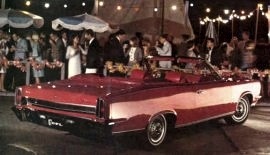 |
 |
AMC Ambassador DPL Convertible |
| |
Also see: AMC Road Tests and Reviews | AMC Brochures |
| |
AMC named the its top-of-the-line Ambassador the least expensive luxury car on the market for 1967. Because it shared its body with the company's middle-range Classic, it was an everyman's car with plush carpets. But AMC did, wisely, go for a larger wheelbase, added a host of niceties and ended up with a very attractive car. Best optioned with the 343 cu. in. V8, the Ambassador came with almost everything, including air-conditioning which was standard. The disc brakes and heavy-duty suspension went an astonishingly long way toward overcoming the appalling imprecision in handling and braking of AMC's cars not so equipped.
The engine, first introduced in 1966, had adequate power, and was a durable unit. But the most striking aspect of the car was the attention to interior and driver and passenger comfort. In this sense AMC was almost schizophrenic with its ultra-austere American and its sybaritic Ambassador. Seating comfort was as highly rated as any U.S. car then on the market, and the quality of materials (including the Rebel-shared ceramic-armoured muffler and tailpipe and acoustical deadening headliner) underscored AMC's positioning of the car in the quasi-luxury market. |
|
 |
 |
 |
AMC Ambassador |
| |
Also see: AMC Road Tests and Reviews | AMC Brochures |
| |
Production of the Ambassador was down in 1967 (to 50,391 from 1966's 68,084), despite a restyle and larger 118 inch wheelbase. The 232 CID Six remained, but there was now a new 290 CID 200 hp V8, and a 343 CID V8 that offered a de-tuned 235 hp or high performance 280 hp. Prices ranged from US$2515 to $3143. The 880 2 Door was $2519, while the DPL gained rally lights inserted into the grille, and a hood ornament. |
|
 |
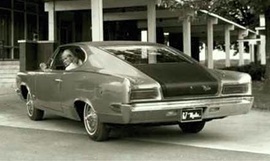 |
 |
AMC Marlin |
| |
Also see: AMC Road Tests and Reviews | AMC Brochures |
| |
For 1967 AMC made the Marlin part of the Ambassador line, and was now using the same 118 inch wheelbase. Engines included the 232 CID 155 hp six, a new 290 CID 200 hp V8, and 2 new 343 CID V8's, offering up to 280 hp. Rally lights were put into the grille, while the round medallion was removed from the rear deck. There were new smoother body sides, along with a rectangular gas filler door. The base price was raised to $2963, and only 2545 would be built. Unfortunately, 1967 was the end of the line for the Marlin. |
|
 |
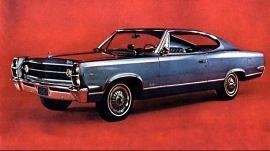 |
|
 |
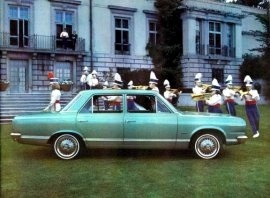 |
 |
AMC Rambler American 440 |
| |
Also see: AMC Road Tests and Reviews | AMC Brochures |
| |
Deep in the heartland of the USA, there was a great and abiding affection for all things American. And that loyalty extended to AMC's econo-car of the same name. The American was 1967's lowest priced car, and was the embodiment of all homely virtues: it was plain, it was functional, it was unpretentious. The basic model (which was indeed very basic) was powered by a 199 cu. in. Six, and AMC were touting the package as the USA's answer to the VW. With the optional automatic - which was ordered on most Americans - the car is no more than a device for transport in the simplest, slowest fashion. That, AMC believes, has considerable appeal to the non-ear-loving public. The 3-speed automatic was in keeping with the car; it was not the smoothest automatic in the world, but it worked. The same can be said of the engine. |
|
 |
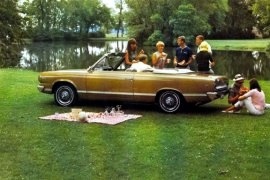 |
|
 |
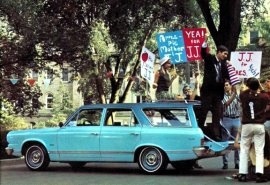 |
 |
AMC Rambler American Wagon |
| |
Also see: AMC Road Tests and Reviews | AMC Brochures |
| |
The Rambler American Wagon had acceptable room for passengers, however the driver wasn't so lucky, with the steering wheel coming very close to the chest. The seats were on the thin side, no boon for occupants who were not the same. In size, the American was better suited to U.S. roads than imports, but in sex appeal, it took a back seat, even to the VW. |
|
 |
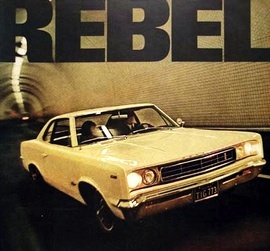 |
 |
AMC Rambler Rebel Coupe |
| |
Also see: AMC Road Tests and Reviews | AMC Brochures |
| |
AMC launched the Rebel in 1967, and it would remain in production until 1970. It used a 114 inch wheelbase, and came with a 232 CID 145 hp six, or 290 CID 200 hp V8. Prices started with the "550" at $2739, the "770" from $2863, the "ungrained" wagon from $3155 and the SST convertible from $2872. The 1967 ½ models introduced the Mariner wagon, which featured a unique anchor decor on the upholstery. These late 1967 models could be ordered with various unique woodgrain and interior finishes, including a bleached teakwood plank woodgrain effect on the body. |
|
 |
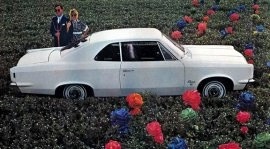 |
 |
AMC Rambler Rebel Coupe |
| |
Also see: AMC Road Tests and Reviews | AMC Brochures |
| |
The AMC Rebel became known as the Rambler Rebel in 1967, and would remain in production until 1970, replacing the Rambler Classic. The Rebel was replaced by the similar AMC Matador for the 1971 model year. The Rebel was assembled from Complete knock down (CKD) kits under license in Europe (by Renault), in Mexico (by Vehiculos Automotores Mexicanos), and in Australia (by Australian Motor Industries). Rebels continued to be sold in these and other markets under the "Rambler" brandname. |
|
 |
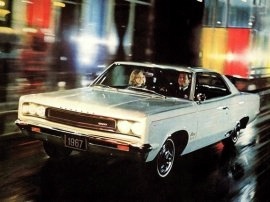 |
|
 |
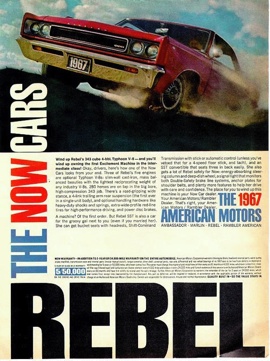 |
 |
AMC Rambler Rebel SST |
| |
Also see: AMC Road Tests and Reviews | AMC Brochures |
| |
When American Motors decided to meet the Big Three competition head on, the Rebel SST was scheduled to be a big gun in their assault. Styling was changed to be more look-alike, and the name of the series was changed from "Classic" to "Rebel" to make it more masculine, active, clean-cut and hardting. Unfortunately, the same 290 cu. in. V8 remained, there was the same imprecision in handling and stopping, and with it, a falling off in quality control. AMC had made much of its flexibility as a "small" manufacturer. |
|
 |
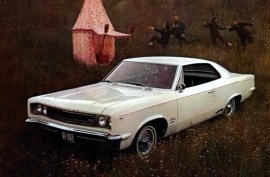 |
 |
AMC Rambler Rebel SST |
| |
Also see: AMC Road Tests and Reviews | AMC Brochures |
| |
AMC went to some length to make buyers believe they were better able to provide the little touches that distinguished its cars from its mammoth competitors. The trouble was, the Rebel's doors still needed slamming to shut properly, and pieces of the insides had an alarming tendency to come adrift. Nonetheless, the basic mechanicals were good enough for a life expectancy of 10-20 years and the 290 V8, while not exciting, was a good workhorse engine, clearly not over-stressed at its 200-hp ratting. |
|
 |
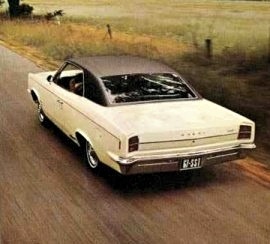 |
 |
AMC Rambler Rebel SST |
| |
Also see: AMC Road Tests and Reviews | AMC Brochures |
| |
Road testers noted that visibility was not as good in the SST than in its plain-jane sisters, however perhaps this was only an illusion because of the trinkets AMC added to try to glamorize the car. Despite the whiz-bang "SST" designation the Rebel, at least with the 290 cu. in. engine, couldn't touch the other Super Cars. |
|
 |
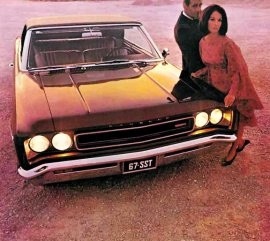 |
|
 |
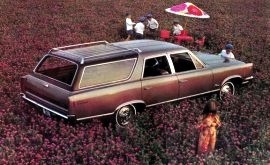 |
 |
AMC Rambler Rebel Wagon |
| |
Also see: AMC Road Tests and Reviews | AMC Brochures |
| |
During the 1967 model year, AMC issued a series of specialty Rebel station wagons with luxury equipment. They were limited for sale to geographical areas. Standard equipment included a 290 cu in (4.8 Litre) V8 engine, while the 343 cu in (5.6 Litre) was optional, automatic transmission, power steering, power drum brakes, and special duty springs and shock absorbers. Each featured a distinctive interior and exterior trim: The Mariner (600 units) in Barbados blue with panels trim of simulated bleached teakwood planking accented by narrow black horizontal stripes and a "nautical anchor" medallion. The interior featured anchors and stars decorating dark blue suede bolster panels of the seats, which also had white piping and broad horizontal pleated inserts of medium blue antelope grain vinyl. The Mariner was sold along the coastal regions of the United States. The Briarcliff (400 units) in Matador Red with simulated black camera grain side panels and "regal" medallions, as well as its own black "antelope grain" vinyl interior. The Briarwood was marketed in major markets in the east and south. The Westerner (500 units) in Frost White with plankwood trim side inserts and a "Pony Express" medallion. The interior featured stallion brown vinyl that simulated "richly tooled" leather on the seats and door panels in combination with white antelope grained vinyl. The Westerner was available west of the Mississippi River. Each version included the color-coordinated upholstery and door panels, individually-adjustable reclining seats, sports steering wheel, as well as the 91 cubic feet (2.6 m³) of carpeted cargo room, a locking hidden compartment, and a rooftop luggage rack. Special regional nameplates were on the rear fender in addition to the unique medallions on the C-pillar. |
|
 |
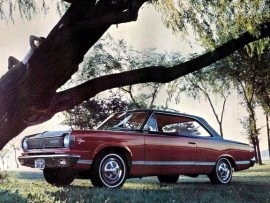 |
|
 |
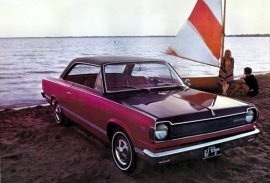 |
|
 |
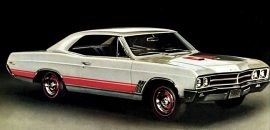 |
|
 |
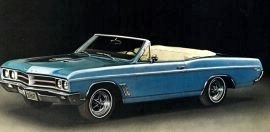 |
|
 |
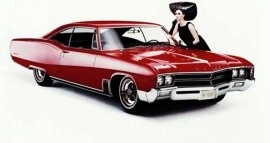 |
|
 |
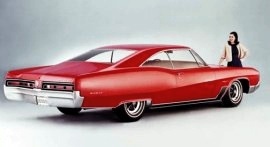 |
|
 |
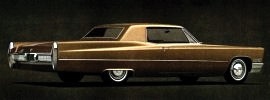 |
|
 |
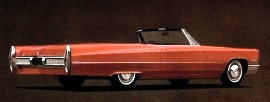 |
|
 |
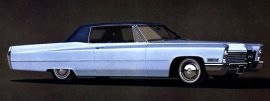 |
|
 |
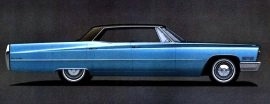 |
|
 |
 |
|
 |
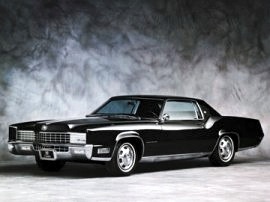 |
|
 |
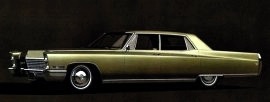 |
|
 |
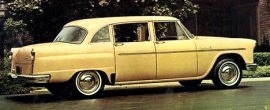 |
|
 |
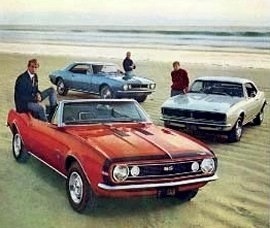 |
 |
Chevrolet Camaro |
| |
Also see: Chevrolet Road Tests and Reviews | Chevrolet Brochures |
| |
In 1964, General Motors gave the "green light" and go-ahead for the F-car project, in response to Ford's Mustang "Pony Car." Two years later, the Chevrolet Camaro hit the ground running. From the get-go the Camaro was available in a hardtop coupe and convertible body styles, and could be ordered with nearly 80 factory options and 40 dealer accessories, including three main option packages and a choice of four different engines. The RS package included numerous cosmetic changes including a blacked out grill with hidden headlights, revised parking and tail lights, upgraded interior trim, and RS badging.
The SS package included a modified 350 V8 with an available 396 big block producing 325hp and later a 375hp version, along with simulated air-intakes on the hood, special bumble bee striping, and a blacked out grill. It was also possible to order both the RS and SS packages, and get a RS/SS Camaro, in which case the RS badging took precedence. The Z-28 included mandatory front disc brakes with power assist, and the Muncie 4-speed transmission and was available to the public solely to qualify the car for racing.
The Z-28's 302 V8 was one of Detroit's hottest small blocks, and was created by installing the 283's crankshaft in a 327 small block, which allowed Chevrolet to comply with regulations and stay within SCCA racing's 305 cubic inch limit. Rated horsepower was said to be at just 290hp, but rumoured to be a lot more! The Z-28 also came with competition suspension, broad racing stripes on the hood and trunklid and could be combined with the RS option package. There wasn't any Z-28 badging as it would have attracted to much attention. The Z28 was tough to beat and boasted a 140mph top speed and numerous racing victories. It was in 1967 that a Camaro RS/SS convertible with a 396 engine paced the Indianapolis 500 race. |
|
 |
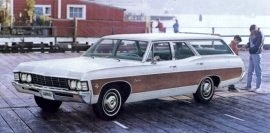 |
|
 |
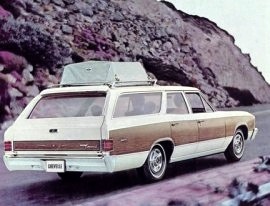 |
|
 |
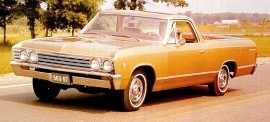 |
|
 |
 |
 |
Chevrolet Impala SS |
| |
Also see: Chevrolet Road Tests and Reviews | Chevrolet Brochures |
| |
The 1967 Impala models were redesigned along the lines of the 1963 Buick Riviera. The Coke bottle shape was strengthened and the curves were biggest with the 1967-68 models. In keeping with Federal regulations, safety features were built into Impalas during the 1967 and 1968 model years, including a fully collapsible energy-absorbing steering column, side marker lights, and shoulder belts for closed models. |
|
 |
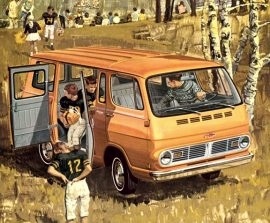 |
|
 |
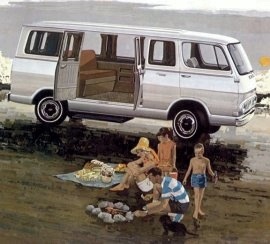 |
|
 |
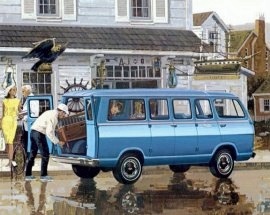 |
|
 |
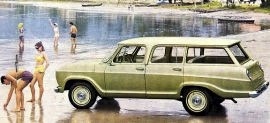 |
|
 |
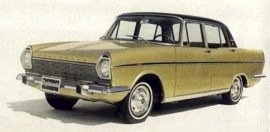 |
|
 |
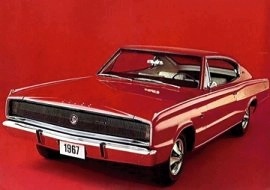 |
|
 |
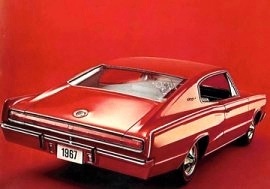 |
|
 |
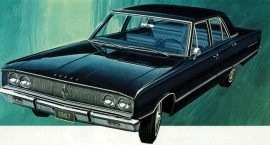 |
|
 |
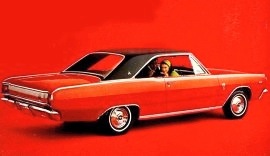 |
 |
Dodge Dart GTS 2 Door |
| |
Also see: Dodge Road Tests and Reviews | Dodge Brochures |
| |
We have gone back through our archives to find one of Dodge's press releases which described the Dodge Dart GTS as a "smooth-handling, corner-hugging road gripper" which, apparently, meant it was pretty good. The Dart GTS was, in fact, a tough little machine on curves and bends, thanks to springs and shocks that were as stiff as any in the industry. |
|
 |
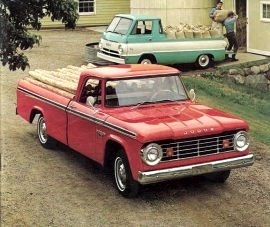 |
|
 |
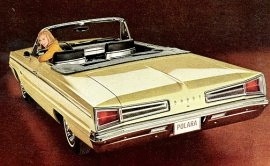 |
|
 |
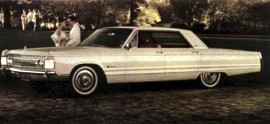 |
 |
Imperial Crown 4 Door Hardtop |
| |
|
| |
|
|
 |
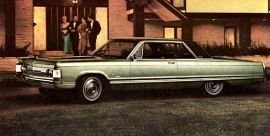 |
 |
Imperial Crown Coupe |
| |
|
| |
1967 saw a completely new Imperial under the skin, as the car changed from a separate chassis to unibody construction to match the rest of the Chrysler Corporation makes. The styling kept the overall straight-line, sharp-edged Engel theme, but there were many detail changes intended to take Imperial away from Lincoln and into its own territory. The spare tire bulge was completely gone from the rear, although the boss remained. The practically full-width taillights spread out from it, straight, but ended before chrome-tipped rear wings. The front end was somewhat similar to 1966's, although the glass lamp covers were gone. New this year was a new entry-level Imperial Sedan, with full frames around the windows unlike the hardtop frameless style of the other cars. A TNT version of the 440 engine was available as an option, delivering more power.
|
|
 |
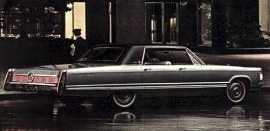 |
 |
Imperial LeBaron |
| |
|
| |
|
|
 |
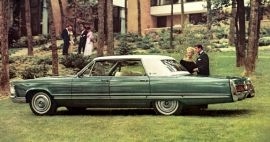 |
 |
Imperial LeBaron 4 Door |
| |
|
| |
|
|
 |
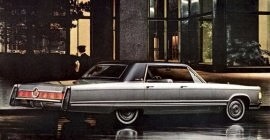 |
 |
Imperial LeBaron 4 Door Hardtop |
| |
|
| |
|
|
 |
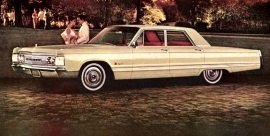 |
 |
Imperial Sedan |
| |
|
| |
|
|
 |
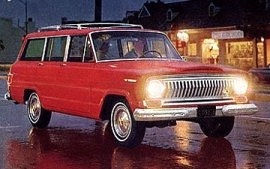 |
|
 |
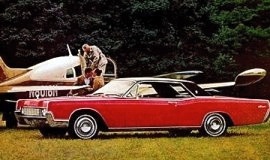 |
 |
Lincoln Continental |
| |
Also see: Lincoln Road Tests and Reviews | Lincoln Brochures |
| |
The Continental was on a downward decline fiddling with sheet metal changes over the previous years had done a lot to take the edge off the basic tasteful lines of the once graceful car. The only engine available was a 340-hp, 462 cu. in. derivative of the 390/428 series. |
|
 |
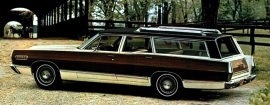 |
|
 |
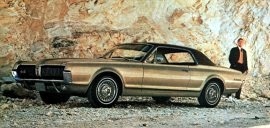 |
 |
Mercury Cougar |
| |
Also see: Mercury Road Tests and Reviews | Mercury Brochures |
| |
The Mercury Cougar has always been a favourite of U.S. car enthusiasts, then and now. We like it because it embodies a combination of comfort, convenience and vice-free handling better than any of its then competitors. In every sense of the word it was a premium car. Particularly pleasant was the obvious emphasis that Mercury had placed upon creature comfort in the design of the Cougar’s interior. The bucket seats were very comfortable (arguably Detroit's best for the time). An adjustable steering wheel is available as an option, permitting the owner to virtually put on his Cougar like a tailor-made suit. Controls were well placed (with the exception of the windshield wiper switch), and, equipped with the versatile 3-speed automatic transmission, the Cougar could be one of the most pleasantly effortless cars on the road. |
|
 |
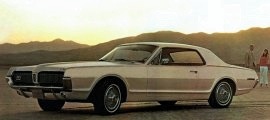 |
 |
Mercury Cougar |
| |
Also see: Mercury Road Tests and Reviews | Mercury Brochures |
| |
Cougars were available with several different engines offering several different levels of performance-including the brute, tire smoking, hell-bent-for-action GTE package which came with a detuned version of Ford’s 427 NASCAR "Wedge." While it was impressive, most were well satisfied with something tamer. You can pretty much buy any version of the Cougar (if you are lucky enough to find one) and you'll love it. |
|
 |
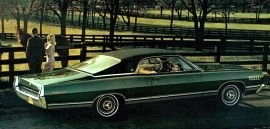 |
|
 |
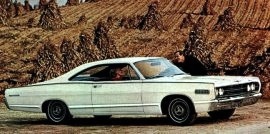 |
|
 |
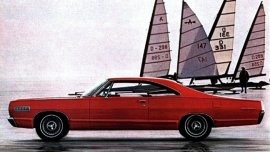 |
 |
Mercury Monterey 2 Door Hardtop |
| |
Also see: Mercury Road Tests and Reviews | Mercury Brochures |
| |
The Monterey was the foundation to Mercury's full-size model line-up, and boasted no less than five separate rooflines (then a record) which were described in terms ranging from "formal" to "fastback" depending on the rake of the rear window, and included the utilitarian (if not very attractive) "Breezeway" rear window. Unless you were particularly hung-up on rooflines, however, the Monterey had little to offer the enthusiast other than good old Detroit-type reliable transportation. Handling, at least with the standard suspension, could best be described as toasted marshmallow - a trade-out for a smoother, quieter ride. Performance, with the 280-hp, 390 cu. in. engine was understandably lacklustre. The interior was roomy, but the appointments were not particularly stimulating in terms of trim design, or quality of workmanship. |
|
 |
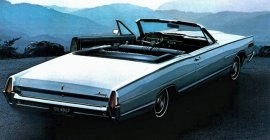 |
|
 |
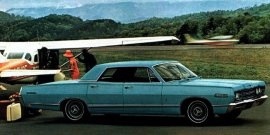 |
|
 |
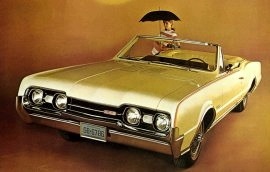 |
 |
Oldsmobile 442 Coupe |
| |
Also see: Oldsmobile Road Tests and Reviews | Oldsmobile Brochures |
| |
Oldsmobile's 4-4-2 never attained the dedicated following of Pontiac's GTO, even though it was the best balanced Super Car at the time. Its handling was noticeably more predictable and more precise than the other light bodied/big-engined street racers, performance was on a par with most, and for overall comfort and enjoyment, the 4-4-2 was a standout - in its own subtle way. Those not wanting to lose their driver's license would stick with the standard 350hp, 400 cu. in. engine. A "select-fit" version (presumably one step down from a blue-printed engine) came with the optional Ram Air package, but this bordered on being a strictly-for-the-strip combination.
Unlike the pronounced understeer that was present on most cars made in the U.S, the 4-4-2 was a surprisingly neutral handling car. This was mostly due to the use of a rear anti-sway bar (which also helped control axle hop under both heavy acceleration and hard braking). The optional front disc brakes were worth every cent. The drums were adequate, but since the 4-4-2 could be driven like a sports car, most found the fade free discs to be more in keeping with the car's capabilities. |
|
 |
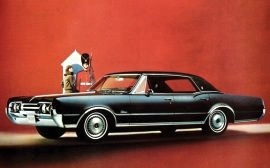 |
 |
Oldsmobile Cutlass Supreme Holiday 4 Door |
| |
Also see: Oldsmobile Road Tests and Reviews | Oldsmobile Brochures |
| |
The 1968 (released in '67) Cutlass was bigger, more powerful, and understeered even more than the 1966 iteration, and although the new sheet metal looked good, the car as a whole had suffered in the transition. Engine displacement was increased from 330 cu. in. to 350 cu. in. The GM 2-speed HydraMatic was carried over, so overall performance was virtually unchanged. One difference that was immediately noticeable to Olds aficionados was in handling where more designed-in understeer was a result of modifications to the rear axle suspension geometry.
At the same time spring rates were lowered to overcome some of the harshness the previous year's Cutlass buyers complained about. The net result was that the '68 Cutlass was sluggish to respond to commands from the helm - not much of an improvement over the previous iteration. The standard 4-wheel drum brake system was one of the best, but disc brakes (which were optional) offered the security of greater resistance to fade and were a much better option. There was also a novel horn ring incorporated into the steering wheel. |
|
 |
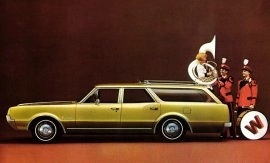 |
|
 |
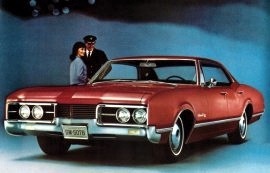 |
 |
Oldsmobile Delmont 88 Holiday 4 Door Sedan |
| |
Also see: Oldsmobile Road Tests and Reviews | Oldsmobile Brochures |
| |
The Oldsmobile Delmont 88 was introduced for 1967 and produced for just two years. It replaced both the Jetstar 88 and Dynamic 88, featuring the 330 V8 as standard and the 425 V8 as an option. The 425 was standard on the Delta 88. The Delta 88 gained a new subseries called the Delta Custom which had a plusher interior than the standard Delta 88 featuring a Strato bench seat in the Holiday (4-door hardtop) sedan or, in the Holiday (2-door hardtop) coupe, a choice of either Strato bucket seats with console or Strato bench seat with armrest. |
|
 |
 |
 |
Oldsmobile Delmont 88 Holiday 2 Door Sedan |
| |
Also see: Oldsmobile Road Tests and Reviews | Oldsmobile Brochures |
| |
The Delta Custom Holiday Coupe was essentially a successor to the former 88-based Starfire series offered in previous years (1961–66) but with a standard 88 semi-fastback roofline rather than the Starfire's squared off roof with concave rear window. New options for 1967 included front disc brakes, stereo 8-track tape player and a Climate Combustion Control system for Rocket V8s designed to regulate carburettor air temperature, boost fuel economy, speed choke warm up and eliminate winter icing to permit easier starting and more efficient operation in cold weather. |
|
 |
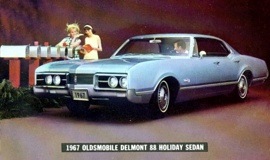 |
 |
Oldsmobile Delmont 88 Holiday 4 Door Sedan |
| |
Also see: Oldsmobile Road Tests and Reviews | Oldsmobile Brochures |
| |
More rounded styling cues marked all 1967 Olds 88 models which received longer hoods and shorter decks and more sweeping fastback rooflines on 88 Holiday coupes to emulate the styling of Olds' front wheel drive flagship, the Toronado. The same assortment of 330 and 425 cubic-inch V8 engines were carried over from 1966, as were most transmission offerings except the optional four-speed manual with Hurst shifter, which was discontinued due to low buyer interest. |
|
 |
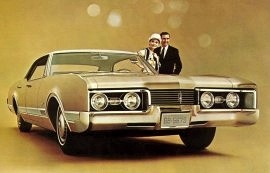 |
 |
Oldsmobile Delta 88 Custom Holiday Sedan |
| |
Also see: Oldsmobile Road Tests and Reviews | Oldsmobile Brochures |
| |
Many were sceptical that Oldsmobile’s economy "Turnpike Cruiser" concept would be the way to go in the Delta 88. The car was not a featherweight in the first place, and, with its lower numerical axle ratio and identical horsepower rating to the '67 model, most thought the '68 version would be a stone. But, by redesigning the camshaft to develop peak torque at lower rpm and increasing the torque converter ratio, Oldsmobile were able to produce a drive train combination which resulted in a car with almost identical performance to its predecessor.
Acceleration from a standstill was comparable, and even at normal highway cruising speeds (when the engine was loafing along at relatively low rpm) the big 455 cu. in. V8 had enough power in reserve for safe passing. That said, it was not exactly what you would have called "instant response" however, and for someone demanding more than routine transportation, the Olds Delta 88 didn't fill the bill. The rear leg room was not what you would have expected in a car with the Delta 88's overall dimensions, and the interior was an uninspired collage of then contemporary styling incorporating the latest from the plastics industry. The protruding front fenders with vulnerably-positioned parking lights, out of the driver's line of vision, could make tight parking situations a shattering experience. |
|
 |
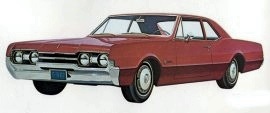 |
|
 |
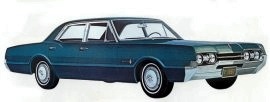 |
|
 |
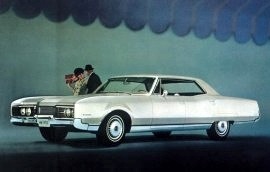 |
|
 |
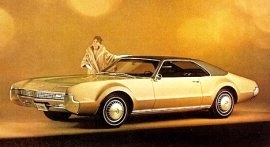 |
 |
|
| |
Also see: Oldsmobile Road Tests and Reviews | Oldsmobile Brochures |
| |
By 1967 it had been two years since Oldsmobile had introduced the Toronado and proved to a sceptical public that it was feasible to build a big, big-engined, front wheel drive specialty car. In 1966 Cadillac's Eldorado stole some of the Toronado's thunder, but Olds still had a good thing going. For the '68 model, the engine displacement was increased to 455 cu. in. on the standard Toronado. As in the past, the big car understeered, but no more so than most other Detroit full-size sedans of the era, and it was a lot better than some. Trouble was, the Toronado wasn't sold as a full-size sedan, and for that reason many expected more from it.
The brakes were always a sore point with road testers, as they were not up to the job of hauling the behemoth down from high speeds without a lot of slewing, but thankfully there was a disc brake option that was a considerable improvement. The strange thing about the Toronado was that it did not feel like a front wheel drive car. The only time you would really notice any difference in day-to-day driving was on wet roads. The advantages of FWD were negated by poor brake modulation; drivers becoming uncomfortably aware of the car's unconventional drive system as they found the car pivoting around itself on the front wheels whenever they hit the brakes too hard and the wheels were not aimed dead ahead. |
|
 |
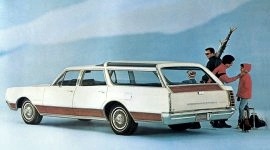 |
|
 |
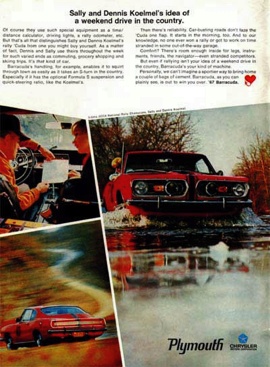 |
 |
|
| |
Also see: Plymouth Road Tests and Reviews | Plymouth Brochures |
| |
After several years as somewhat lacking in the bollocks department, the Barracuda grew some serious cohunes for 1967. Plymouth had let the Barracuda putter through life with a feckless 273 cu. in. V8, but in 1967 it was fitted with their throbbing new 340 cu. incher that acted and sounded like a junior varsity Hemi. The Plymouth people had known for some time that the Barracuda lacked the rough-and-tumble personality that would endear it to the enthusiast market, and several abortive corrections were tried.
First they installed a noisy muffler that succeeded only in infuriating the cops, then in 1966 they wedged in the big-car 383 4-barrel V8 engine, but it was so massive that power steering wouldn't fit, and it took an NFL linebacker to park it. But for 1967 the 340 put Plymouth right into the program. The '67 Barracuda had plenty of performance (plus excellent handling), to run with the standard Mustang’s and Camaro’s. The standard 'Cuda mill was a 318, but most decided on the 340 or nothing. The Plymouth stylists managed to cunningly disguise the notch back and convertible Barracudas to look like Valiant’s, so only the original fastback had any truly distinctive lines. If you can find a good 340 - you are on to a very good thing. |
|
 |
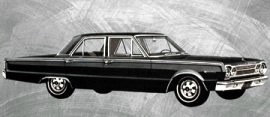 |
|
 |
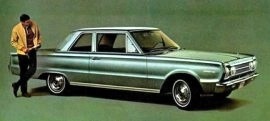 |
|
 |
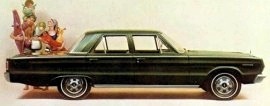 |
|
 |
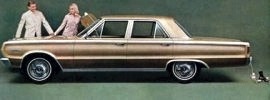 |
|
 |
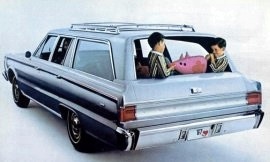 |
|
 |
 |
|
 |
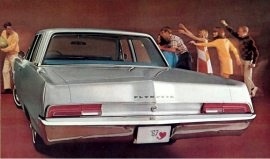 |
|
 |
 |
|
 |
 |
|
 |
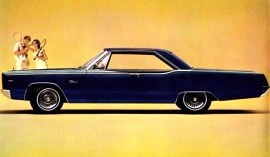 |
 |
Plymouth Fury III |
| |
Also see: Plymouth Road Tests and Reviews | Plymouth Brochures |
| |
That the Fury III was not America's sweetheart was a sad reflection on the taste and perception of the American public. The '67 Fury was Plymouth's entry in the mass-class sweepstakes so handily dominated by the Chevrolet Impala and the Ford Galaxie, and was a truly outstanding machine for the money. It was tastefully styled, both inside and out, and felt taut and silent under even the nastiest road conditions. Comfort was impressive, although Plymouth had, to its everlasting credit, resisted the temptation of providing the kind of jello-bowl suspension that had become the norm on the big Chevys and Fords of the era. |
|
 |
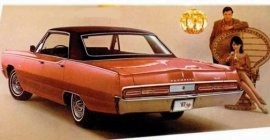 |
 |
Plymouth Fury III |
| |
Also see: Plymouth Road Tests and Reviews | Plymouth Brochures |
| |
Visibility in the Fury was very good and the driver could make it down the highway with a Fury III and honestly feel that he had some direct influence over what the machine was doing. No question, the Fury II and III (the latter had better trim) models were the best-handling cars in the so-called "volume" segment of the auto market. The standard V8 for the Fury was a lusty 318 cu. in., 2-bbl. V8, and this, if anything, was its achilles heel. The Fury deserved more performance (with no sacrifice in economy), and so the better choice was to option the 383 V8. |
|
 |
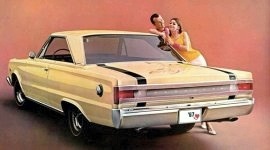 |
 |
Plymouth GTX |
| |
Also see: Plymouth Road Tests and Reviews | Plymouth Brochures |
| |
The GTX was Plymouth's jumbo street racer, complete with all the acceptable props - hood scoops, bucket seats, mag-type wheels, zoomie medallions and stripes plus a very neat engine/chassis combo. The standard GTX engine was the muscular Super Commando 440 cu. in. High-performance version. This massive, free-breathing power plant was gutsy enough that it would make the GTX perform nearly as impressively as the optional, more expensive, slightly more temperamental Hemi. Coupled with the ultra-tough, ultra-flexible TorqueFlite 3-speed automatic (you only needed the 4-speed manual if you were intent on street drags), the 440 would do all the tricks and keep running forever.
The Chrysler Corporation B-body, from which the GTX was derived, featured as neatly articulated yet as conventional a suspension system as there was in the USA. The heavy-duty shocks and springs that come on the GTX made it one of the most agile intermediates in the business. Add to this a set of 11-inch disc brakes at the front and you had plenty of stopping power for a car that would come out of the gate with the best of 'em, and cruise for hours at 80 mph. It looked good, the interior was tasteful, if slightly uninspired, and the GTX offered a load of civilized performance for the money. If you can find a good example, grab it. |
|
 |
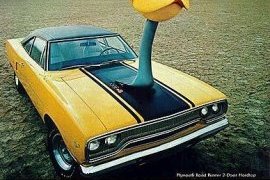 |
 |
|
| |
Also see: Plymouth Road Tests and Reviews | Plymouth Brochures |
| |
The Road Runner was originally conceived as a stripped Plymouth Belvedere, stuffed full of enough horsepower to make it a showroom version of the de-chromed, super-cool Q-ships that Young America drove on the street during the late 1960's. The project has, by-and-large, been completed without compromise, although the stylists and product planners couldn't resist overstating the non-functional hood scoops. Within the context of this market, the name was a stroke of genius, and Plymouth exploited it for all it's worth. The Road Runner was basically a Belvedere I, which was Plymouth's low-buck fleet special, equipped with a specially-tuned 383 cu. in., 4-bbI. V8 and heavy-duty suspension.
The result was the world's fastest club coupe. The interior trim was a bit sparse although improved upholstery soon followed its release. The car, like all Chrysler intermediates with heavy-duty suspension, handled very well, and the 383 gave it plenty of power for the street racing scene. However, if you were really serious about the whole thing, you would spend the extra money for the fabled Hemi, which put the Road Runner right there with the 427 Corvette. This was the first car since the GTO to be aimed directly at American youth and it was dead on target. |
|
 |
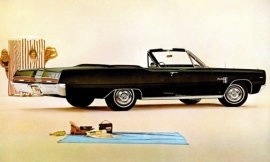 |
|
 |
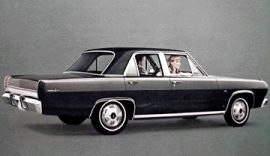 |
 |
Plymouth Valiant Signet |
| |
Also see: Plymouth Road Tests and Reviews | Plymouth Brochures |
| |
The Plymouth Valiant Signet was "America's Economy King." Thanks to a long-sought, hard-fought win in the 1967 Mobil Economy Run, Plymouth were at last able to brag a bit about its drab Valiant. This was an important matter to Plymouth because sales had been dropping for the past few years, and unless something was done, the Valiant wouldn't enjoy much more time on the assembly line. Like the Corvair and the Falcon, the Valiant had been around since Detroit's automotive wizards discovered the compact car a decade earlier, and, like its then aging compatriots, all attempts to market it as a semi-sporty car in the late 1960's had long since disappeared over the horizon.
So the Valiant was seen, in the U.S. anyway, as an "economy king" pure and simple. Those willing to subordinate all other standards of automotive performance for a few extra mpg could buy the cleanly-styled Valiant with a 115-hp Six and a 2.76-to-one rear axle ratio. Needless to say, this was the set-up that won the Mobil Run. Without question, the most satisfactory engine for the Valiant was the 190-hp, 273 cu. in. V8 coupled to a TorqueFlite or 4-speed transmission. This gavs the Valiant Signet adequate power for short-haul driving, but then the question for mileage fans arose, how would it do in the Mobil Run? Conversly, in the Southern hemisphere Australian's could not get enough of the Valiant. |
|
 |
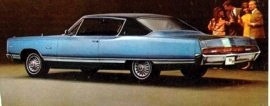 |
|
 |
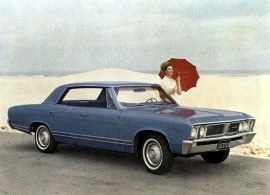 |
|
 |
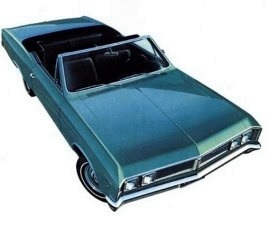 |
|
 |
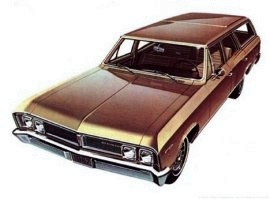 |
|
 |
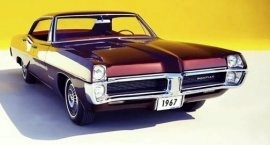 |
 |
|
| |
Also see: Pontiac Road Tests and Reviews | Pontiac Brochures |
| |
Pontiac's base model was the Catalina. Above that was the Executive, fitted with deluxe trim and additional standard amenities, and riding on a longer wheelbase and having a longer length. Under the bonnet, the Executive and Catalina were similar. |
|
 |
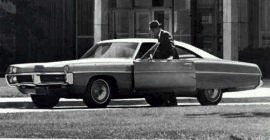 |
 |
Pontiac Executive 2 Door |
| |
Also see: Pontiac Road Tests and Reviews | Pontiac Brochures |
| |
The Pontiac Executive was produced from 1967 through 1970 with their strongest year of sales occurring in 1967, with 35,491 units produced. The Executive replaced Pontiac's mid-range Star Chief, with the Star Chief Executive name being used for one year (1966) before the series became known as just 'Executive' in 1967. Both had the same standard and optional V8 engines. The base unit was a 400 cubic-inch V8 with a two-barrel carburettor and offering 265 horsepower. The standard gearbox was a three-speed manual with a floor-mounted four-speed with Hurst shifter optional in 1967 and 1968. Most buyers purchased the Executive with the optional three-speed Turbo Hydra-Matic automatic. |
|
 |
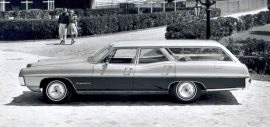 |
 |
Pontiac Executive Wagon 3 Seat |
| |
Also see: Pontiac Road Tests and Reviews | Pontiac Brochures |
| |
The Pontiac Executive replaced the long running mid-range Star Chief. Dubbed the "Star Chief Executive" for 1966 only, the model simply became the ‘Executive' in 1967. Sold as an entry level Pontiac, it was obviously not as luxurious as the top-line Bonneville, however it did share the Bonneville's wheelbase and other dimensions. The Executive showcased deluxe trim, a longer wheelbase and overall length than the lower-priced Catalina models and much more standard amenities.
The mechanical components were virtually on par with the Catalina, as they shared similar standard and optional V8 engines. The base 400 in³ V8 with two-barrel carburettor was rated at 265 hp and ended with a 390 hp 428 in³ HO V8 until 1969. In 1970 a larger 455 in³ V8 was introduced and was rated at 370 hp. Each year the standard transmission was a three-speed manual with column shift. Optional in 1967 and 1968 was a floor-mounted four-speed with Hurst shifter optional. 98% of Executives were fitted with the three-speed Turbo Hydra-matic automatic during its four-year production run.
Executives came in a variety of body styles that included a two-door hardtop, a four-door pillared sedan, two-door hardtop coupe, four-door hardtop sedan, and hardtop station wagons in two and three-seat versions. The main difference separating the Executive Safari wagons from the Bonneville and Catalina Safari wagons by featuring simulated wood paneling. In 1967 a total of 35,491 Executives were produced, followed by 35,597 the following year, 25,845 in 1969 and 21,936 in 1970. Unfortunately sales had dropped so much by 1971 that the decision was made to discontinue the Executive and replace it with the newly-midlined Bonneville. |
|
 |
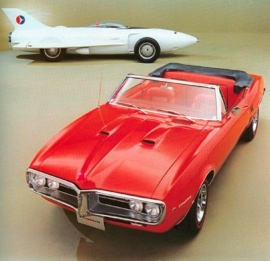 |
 |
Pontiac Firebird |
| |
Also see: Pontiac Road Tests and Reviews | Pontiac Brochures |
| |
The Pontiac Firebird melded sports with European chic, with plenty of individuality on offer courtesy of an extensive option list. And something in between if you can't seem to make up your mind. The biggest change for the 1968 model (from arguably the US industry's most prolific innovator) was a redesigned rear suspension intended to eliminate axle hop which had plagued the previous year's model.
The new multiple leaf springs and staggered shock absorbers helped, but the axle still wasn't perfectly behaved. Handling, conversely, was excellent, lending confidence to even the most maniacal driving. Ride comfort, even with the optional heavy duty suspension, was very good. The interior appointments of the Firebird were acceptable - but not exceptional. Biggest of the dissappointments were the seats, which remained unchanged from the previous year.
Another change many had wished for, but did not get, was making the 3-speed automatic available with the 350 cu. in. engine, which needed all the help it could get. The 2-speed just wasn't versatile enough. Some also bemoaned the elimination of side vent windows, particularly as the new dash-mounted fresh-air vents (although a much better idea) did not pass much air, and there wasn't adequate means for exhausting stale air. Small gripes though, in a thoroughly brilliant car. |
|
 |
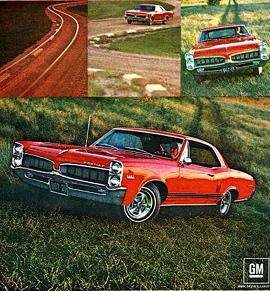 |
 |
Pontiac Le Mans Sprint |
| |
Also see: Pontiac Road Tests and Reviews | Pontiac Brochures |
| |
Shortly after Pontiac provocatively christened its high-line Tempest model the Le Mans, they rolled out the GTO, eclipsing the Le Mans so totally that it never had a chance to become established in the enthusiasts' market. Equipped with the overhead cam Six, the Le Mans was undoubtedly the most European-in-concept of any car then made in America, a point that Pontiac liked to hammer home whenever given the chance. Performance was on a par with many of Europe's medium-priced, small-displacement sports sedans; its handling was viceless, but most wanted more power to get the rear end out.
The brakes worked well (but pedal pressure was high), seating comfort was fine for short periods. In short, the Pontiac Le Mans Sprint was too European in concept for typical American driving conditions. On the old Interstate acceleration was mediocre, and around town you would have to work the engine a lot harder, braking, then clutching. If you take an uninhibited trip down a secluded back country road the Le Mans would "almost" make up for all these drawbacks. Driving was fun again; you were in command of the car, not vice-versa. If any American-made car deserved a Continental name, this was it. |
|
 |
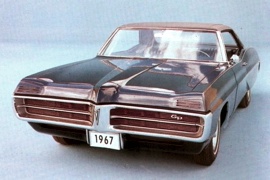 |
 |
Pontiac Grand Prix |
| |
Also see: Pontiac Road Tests and Reviews | Pontiac Brochures |
| |
The Pontiac Grand Prix was the biggest sports car for 1967. In fact, the word "Grand" rings of understatement. If Mercedes-Benz had of built it, they wouldn't have hesitated to call it the Grosser Preis. Pontiac was both more Gallic and more modest. Road testers of the day were taken, understandably, by the Grand Prix's style. Every visible part of the car exuded the stylists' influence. Typical of the attention Pontiac paid to detail were the letters "G P" etched in the corner of the door glass where the previous models vent windows used to be. Inside the attention to detail was followed through, and unlike many of the smaller Pontiac models, the seats gave excellent support. The Grand Prix was quiet, offered a smooth ride, and supported Pontiac's claims as to superiority of frame-type construction over the integral body chassis approach. The performance and roadability of the Grand Prix were excellent. Only its size (a 121-inch wheelbase) and its weight (well over 4000 ground-crushing pounds) kept the Grand Prix from being a Super Car. They are highly sought after today, and for good reason. |
|
 |
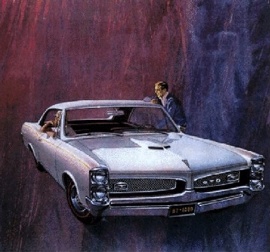 |
 |
Pontiac GTO |
| |
Also see: Pontiac Road Tests and Reviews | Pontiac Brochures |
| |
Never a Division to rest on its laurels, Pontiac had its stylists and engineers hard at work on the GTO ever since its introduction in 1964. There were few cars, domestic or foreign, that could boast better handling without an accompanying general deterioration in overall ride comfort. The only complaint of some car reviewers of the day was in the suspension department, the GTO suffering severe rear axle hop during hard braking from over 80 mph. The car still stopped in a hurry, but the shaking and sudden noise scared the hell out of those not familiar with the trait.
What was even more perplexing was the issue was there in the first place, given the seemingly adequate number and strength of the links locating the coil-sprung rear axle - the old leaf spring setup was no more, but the judder made it feel like it was still there! The GTO had an uncannily responsive engine which gave the driver a feeling of supreme confidence. Other manufacturers built Super Cars with more brute acceleration, but when it came to building a fully integrated package that combined ride comfort, handling, style and performance - all at a bearable price - the GTO was very tough to beat. |
|
 |
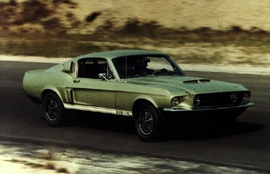 |
 |
Shelby Cobra GT 350 |
| |
Also see: Pontiac Road Tests and Reviews | Pontiac Brochures |
| |
It is said that the Shelby GT 350 was the Mustang that all Mustangs should have been. When Carroll Shelby created the GT 350 in 1965, it was too much sports car and not enough Gran Turismo. It was a rough, tough, masculine brute, and you had to teach it who was boss. As a conversion of a sporty car, the GT 350 had more sheer guts than America’s only genuine GT car, the Corvette, but it played sweet music to a fairly small audience of hard-core enthusiasts. All that is changed in 1967. The Shelby Mustangs were not exactly emasculated, but they were toned down to the point where any little lady from Pasadena could drive one.
Most of the differences between the stock Mustangs and the Shelby versions was in the styling. The engines were a bit souped up, but they were perfectly tractable, the handling was more sure-footed, and the brakes were improved, but it was done largely with pieces that were optional on regular Mustangs. One part that wasn't optional on any other car in America available in 1967 was a roll-over bar. Shelby also offered racing-type inertia-reel shoulder harnesses. Any Mustang driver who calls himself an enthusiast owes it to himself to try the GT 350 (or its bigger-engined brother, the GT 500). |
|
|
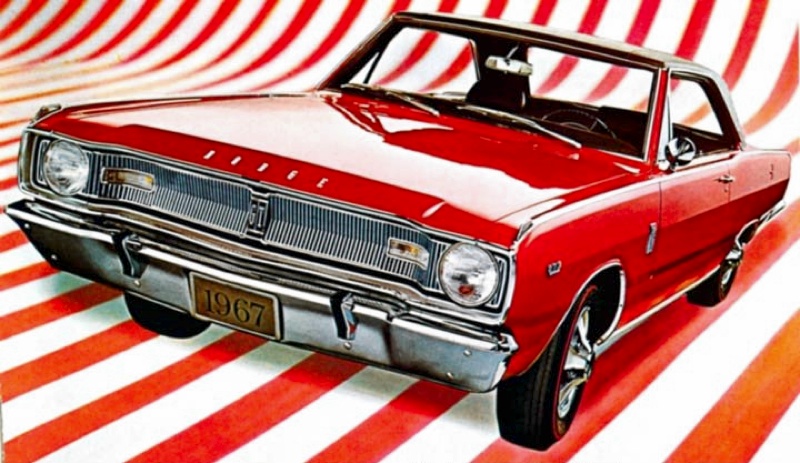 1967 Dodge Dart.
1967 Dodge Dart. |
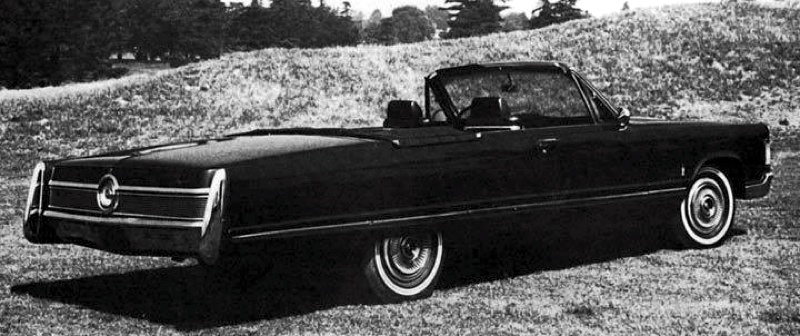 1967 Imperial Convertible.
1967 Imperial Convertible. |
 1967 Pontiac GTO. 1967 Pontiac GTO. |
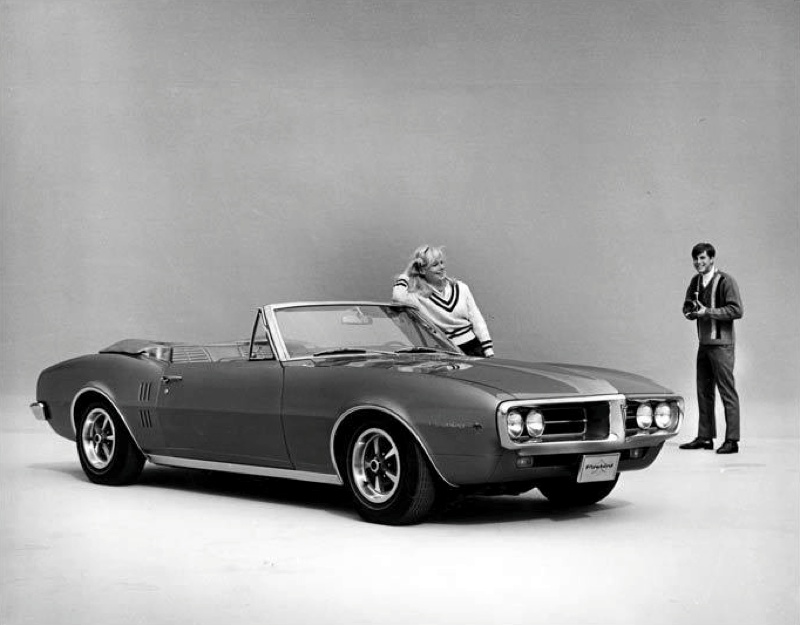 1967 Pontiac Thunderbird.
1967 Pontiac Thunderbird. |
|
| Sell Your Car or Parts Browse the Classifieds It's Absolutely Free! - Find Out More |



